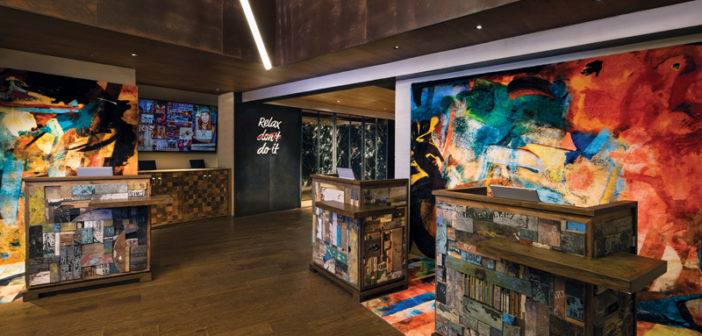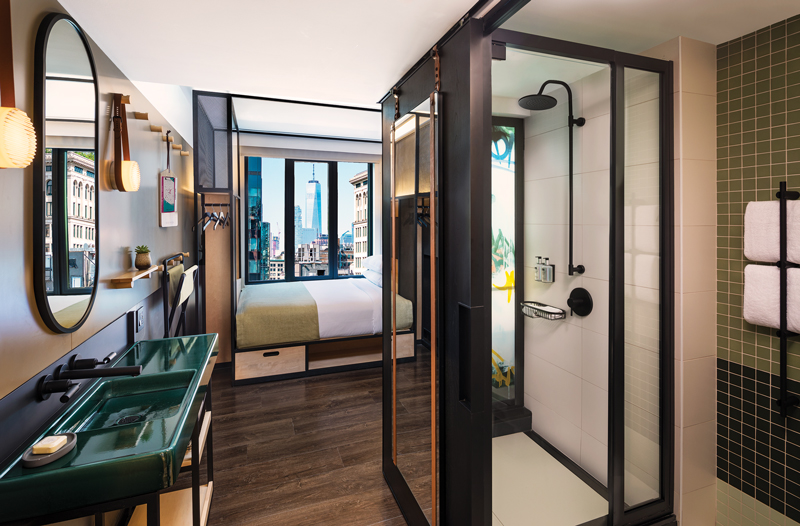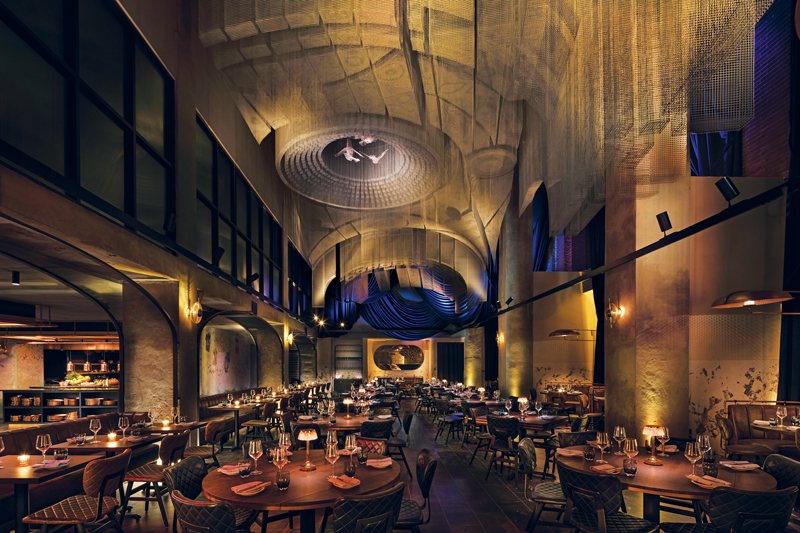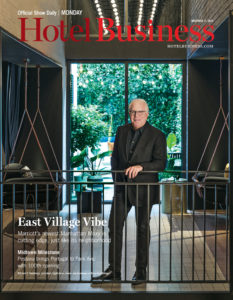NEW YORK—In its heyday, New York City’s East Village neighborhood was legendary—a place that gave rise to edgy punk rock and the musical icons who lived here, such as Patti Smith and Debbie Harry, and the Beatnik movement, to name a few. Here on these historic streets, the original influencer was born.
Today, Marriott International’s Moxy is right at home here. Backed by a team of creatives, the Moxy East Village, which opened in September, is ready to celebrate this neighborhood and share it with the world.
“Moxy Hotels is a brand that has always boldly broken the rules of a conventional hotel experience, and we wanted to bring our fun and spirited brand to the heart of New York’s iconic East Village to help evolve the hospitality scene in the neighborhood,” said Toni Stoeckl, global brand leader, Moxy Hotels, and VP, distinctive select brands, Marriott International. “We wanted to embrace the rebellious spirit of the historic, vibrant area and blur the lines between where the hotel ends, and the city begins. Moxy East Village introduces guests and locals to the neighborhood’s creators, tastemakers and businesses.”
Mitchell C. Hochberg, president of Lightstone, the owner/developer of the hotel, added, “The East Village is New York’s most historically iconoclastic district, a place infused with the spirit of rebellion and the creative, experimental edge of youth. It’s where rock ‘n’ roll, renegade art, LGBTQ+ activism and generations of immigrants all merged to give birth to American counterculture. The neighborhood has always been about pushing boundaries and taking risks, and Moxy East Village seeks to channel that spirit.”
As one of the country’s largest developers with a portfolio of $2 billion in office, retail and industrial commercial properties, Lightstone is known for creating a rebirth of real estate in major cities, including some of New York City’s boroughs. With few hotels around, the team at Lightstone saw an opportunity to make the East Village more accessible to visitors.
“Our goal was to create a property that embraces the unique character of the East Village and its place in the history of American culture while defining what hospitality means in the neighborhood today,” said Hochberg. “What we’ve learned through our first two hotels—Moxy Times Square and Moxy Chelsea—is that today’s generation of travelers has a different set of expectations and values when it comes to deciding where to stay. They see hotels less as places to spend the night and more as a stage for meaningful experiences, authentic interactions, and a deeper understanding of a place.”
Through visual storytelling, the new-build property comes to life to share its past and present, which is evident in the design by Rockwell Group and architecture by Stonehill Taylor. Inspiration was drawn from various eras in East Village history.
Check out our video interviews at video.hotelbusiness.com
“We were super excited to participate on this particular project because of the neighborhood’s richness,” said Greg Keffer, partner and studio leader at Rockwell Group. “What’s interesting is, if you go way back in history, this area used to be a farm. You’ll see hints of that in the design as well. For us, there’s lots of layers of history and it’s almost like an archaeological discovery as you move through the timeline of the East Village and the hotel itself.”
Touching on the brand’s ability to work within the neighborhood, Stoeckl added, “For a brand, it’s important to embrace the locale into a hotel’s point of view from a design perspective. Moxy East Village has done that seamlessly and playfully.”
Each of the hotel’s 13 floors serve as an homage to the East Village’s icon status. “The ground floor, for instance, is connected to the ‘creative dissidents,’ who defined the East Village of the 1980s, the era of punk rock and renegade art,” said Hochberg.
As you enter its doors, there are check-in kiosks comprising assemblages of found objects and materials by local artist Michael Sanzone. Striped tapestries with alternating bands of graffiti and graphics recall shredded layers of wheat-pasted posters much like what you’d find peeling off a downtown building facade.
“The neighborhood has resisted gentrification, but it hasn’t been strenuously preserved, either—which means that these various layers of history and contemporary life coexist like in few other parts of the city,” said Hochberg. “Rockwell Group aimed to capture the spirit of the East Village, allowing guests to uncover its many historical threads.”
“When you walk through the East Village, you see a lot of different colorations, textures and layers,” said Keffer, pointing to posters layered on brick walls that have been torn off. “There’s a sense of beauty in the destruction, in some ways. We played on that. But, we also wanted to play on the richness and the colors you might see that are really beautiful. These tapestries and the really beautiful drapes, and then including art in the story as well. Art plays a major role in this project. It’s the centerpiece of Cathédrale, the restaurant; we have this two-story-high volumetric sculpture that’s really quite incredible.”
Much like the city dwellers who live in pint-size apartments, guests will get a sense of what it’s like to live like a local in the 296 guestrooms that are designed to maximize space and enable guests the flexibility to adapt the room to their needs.
“The five room types all have elements of glass, metal, wood, raw concrete and fabric. The effect is welcoming and tactile, inviting guests to run their hands over the surfaces and creating a sense of intimacy and bungalow-like comfort,” said Hochberg. “Contributing to the cozy, hygge quality is the canopy bed, framed in wood and metal, with a woven headboard made of seatbelt fabric. It incorporates reading lights, a closet and drawers for storage, plus an embedded TV—like a space within a space.”
“Artistic inspiration is provided by specially commissioned pieces by New York photographer Xan Padrón, who shot time-lapse pictures of city dwellers walking in East Village locations and then transformed them into a grid-like composite,” said Hochberg.
To tell the story through F&B, Lightstone selected Tao Group Hospitality, a firm it has a strong working relationship with, to craft four new dining and drinking venues at Moxy East Village—Alphabet Bar & Café, Cathédrale, Little Sister and a rooftop bar set to open in this spring.
“I don’t think there are any places in New York where you can get an outdoor café vibe, a coffeehouse vibe, a dimly lit bar, a backyard rooftop party and a grand dining room all in one,” said Noah Tepperberg, co-founder of Tao Group Hospitality.
Just beyond a wall of broken glass that reflects what Rockwell calls the “beautiful chaos” of punk rock, is Alphabet Bar & Café, a lobby bar and café that includes plush sofas and swinging chairs, plus a Skee-Ball machine to add a hint of nostalgia.
“The base of the bar is made up of organ pipes; the surrounding walls are decorated with theatrical drapes that reveal concrete walls hung with vintage, graffiti-tagged mirrors,” said Hochberg. “An adjacent terrace has alfresco seating and walls planted in tumbling greenery. An interactive real-time graffiti installation will let guests use a tablet to draw their own tag or sketch a bit of street art, like a latter-day Jean-Michel Basquiat or Keith Haring, and see it projected on the wall.”
The centerpiece of Moxy East Village is Cathédrale, a French-Mediterranean restaurant conceived by Executive Chef Jason Hall and Tao Group.
“Here, the narrative shifts to the musical legacy of the 1960s, in all of its decadence and raw creativity. For Cathédrale, Rockwell Group was inspired by the Fillmore East, the legendary ‘Church of Rock ‘n’ Roll,’ revered for its Medieval Revival architecture,” said Hochberg. “As diners descend from the lobby—via a staircase that resembles a fire escape between two East Village buildings—they’ll feel like they’re discovering an abandoned architectural treasure. That’s thanks to the show-stopping main dining room, a soaring, triple-height space covered by a dramatic wire mesh sculpture that looks like the apparition of a grand domed ceiling.”
Lightstone brought in Italian artist Edoardo Tresoldi, who has been named by Forbes as one of the 30 most influential European artists under 30, to conceive an ethereal sculpture for the ceiling of Cathédrale that pays homage to the Fillmore East’s interior.
“The delicate yet monumental sculpture, called Fillmore, is made from Tresoldi’s signature wire mesh and floats above the main dining room, creating a dramatic dialogue with the restaurant’s architecture,” said Hochberg. “The deep chasms and fragmented central dome of the 19-ft. installation evoke the grandeur of the past while remaining firmly contemporary in its execution. Fillmore is already making Cathédrale an East Village destination for art lovers, foodies and anyone fascinated by architecture and history.”
Two levels below ground, a lounge called Little Sister is devoted to the early settlers of the area, which was mostly farmland from the 1650s through the middle of the 19th century.
“A custom wallcovering depicts a bucolic, forested scene—what the neighborhood might have looked like before all the buildings descended on the area. Streaks of gold provide a hint of contemporary richness, as do velvet seating and accents of leather and polished copper. The lounge has a clandestine, cavern-like feel that recalls the East Village’s legendary underground nightlife, while the wood-clad, barrel-vaulted ceilings evoke a hidden underground chamber where whiskey might have been stored in the bootlegger era,” said Hochberg.
“Sprinkled throughout the hotel are defining ‘moments’ that capture visitors’ imaginations,” he said. “The elevators represent a catalyst of change as they bring guests from the lower-floor public spaces to the bedrooms and the rooftop bar. Behind blackened-steel doors, the cab is clad in infinity glass custom-printed with thousands of emojis—representing the language of tomorrow and the idea of infinite possibility.”
The crown on this urban masterpiece will be the rooftop, opening in the spring. It will be designed to resemble a coveted New York City backyard, with strung garden lights, abundant foliage, and colorful patio furniture.
“A retractable roof allows the bar to be used in all seasons. Behind the bar, liquor bottles will be displayed in stacked plastic milk crates—not unlike those you’d spot on an East Village sidewalk,” said Hochberg. “On one wall, interlaced with crawling ivy, will be a mural that overlays a map of the East Village with images from the neighborhood’s musical and artistic history. The artists, Chandler Noah and Diego Catano of En Viu, were inspired by the weathered billboards and layered posters typical of the East Village, and by the work of Robert Rauschenberg, who lived nearby.”
There’s more to come from Marriott’s Moxy brand, which currently operates 46 hotels across North America, Europe and Asia. There are 104 Moxy hotels in the signed pipeline expected to open in North America, Asia, the Caribbean & Latin America, and Europe. HB




